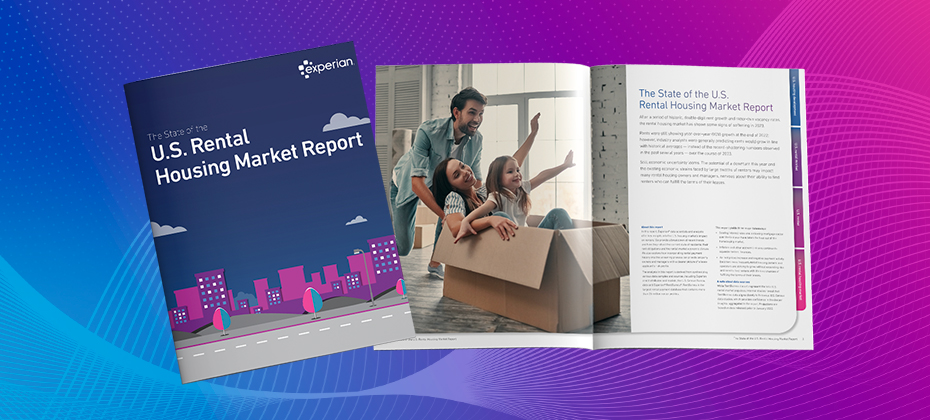Tag: housing

First mortgage delinquencies and foreclosures are increasing, particularly in later stages of delinquency. Home equity delinquencies remain low, signaling stability in that segment. Mortgage originations are up, with refinances beginning to recover. HELOC direct mail offers have surpassed first mortgage offers, driven by aggressive marketing and AVM-based personalization. Lenders using property data in marketing outperform peers relying on volume alone. Strategic focus for lenders: tighten risk analytics, integrate data into marketing, and adopt AVM-based personalization.

Property managers and landlords nationwide aim to attract reliable, long-term tenants. Gaining insight into modern renters—their tenant data, financial situations, lifestyle choices, and key priorities—gives proactive property owners and managers a competitive edge in appealing to the ideal tenant. While certain elements of the rental landscape are not within the control of market professionals, knowledge is power, and understanding the preferences, spending habits, and profiles of today’s renters can inform their business approach and success. To understand today’s renter, Experian® took a deep dive into the tenant data of the rental market landscape in its 2024 report on the U.S. rental market. Among the principal findings, Generation Z and younger millennials' dominance in this sector is rising. Today’s Renter Profile Experian research reveals movements in the demographics of the average U.S. renter, now dominated by younger individuals and lower average-income consumers. These renters face challenges as they navigate the rising costs of securing housing. The 2024 rental report delves into these changes, highlighting age and income level shifts in tenant data. Critical to property managers and landlords, this information offers an understanding of their customer base and provides insight into the rental market landscape. Gen Z on the Rise: Gen Z alone accounts for 30.5% of all renters, and their numbers are increasing, up 3.5% over a year. Gen Z and younger millennials (adults under 35) represent over 50% of the rental population. Income Declines: From January 2023 to January 2024, the tenant data showed the average income of RentBureau® renters fell from $53,100 to $52,600[1]. Higher Rent Costs: In 2024, over 50% of renters paid $1,500+ per month, with the average U.S. renter's monthly payment of $1,713. Gen Z,the youngest renter population, spends an average of $1,600 monthly on rent. This context plays an important role in examining the state of the 2024 rental market. Propensity to Move In addition to age and economic well-being, landlords should take a keen interest in tenant data related to renters’ moving habits, as these provide valuable insights into behavior and market trends. Landlords generally prefer longer-term leaseholders, and renters who stay longer provide more stability to property management efforts. Not surprisingly, generational trends appear here as well. While over 90% of all renters retained one lease over a 2-year period, tenant data indicates that Gen Z and younger millennial renters tend to move more than other age groups. This tendency stems from various factors, including a willingness to relocate to more affordable regions or areas that better suit their lifestyle preferences. With today’s evolving work environment, remote work has opened new possibilities. Again, the overarching trend is that renters stay in one place for two years. In fact, this represents 92.5% of all renters. Signs of Overall Renter Financial Health Housing is a significant monthly cost of living expense, especially for many younger adults just starting out and lower-income individuals and families. The percentage of a renter’s monthly income allocated to rental costs clearly indicates housing affordability. This tenant data reflects that higher rent-to-income ratios (RTIs) signify that renters have less financial flexibility, as a larger portion of their monthly income is allocated to rent, leaving less available for essentials, savings, and discretionary spending. On average, renters spend over 44% of their monthly income on rent, and low-to-moderate-income renters dedicate over 50% to rent. General guidelines suggest that the percentage should be no more than 30%. Higher rental costs and declining annual incomes disproportionately impact those with fewer financial means. Credit and Other Signs Landlords and property managers value tenant data, such as renter applicants' stability. Indicators such as overall credit quality and negative payment history provide valuable insights into economic well-being. While negative payment history has improved slightly, the market shows a rise in delinquencies. Experian’s research highlights that while credit scores for the general U.S. population are on the rise, the trends for renters tell a slightly different story. Between May 2023 and May 2024, tenant data revealed a 2% increase in renters fell into the near-prime and subprime credit categories. Although the implications for the future remain uncertain, this data, combined with other analytics, may offer clues about market trends and opportunities. The Future The demand for rentals remains high, particularly among young adults and lower-income households. As the economy and market forces fluctuate, so do the financial pressures on renters and rental housing availability and costs. The role of young adults and lower-income households in the rental market will continue. Landlords and property managers must tune in to demographic realities in their efforts to develop risk management and success strategies. To learn more about the state of the U.S. rental market, download Experian’s 2024 rental report. [1] RentBureau income is based on modeled income, which is estimated using credit data and other predictive factors.

The Experian Vision conference is an annual event hosted by the leader in global information services. Vision 2024, held in Scottsdale, Arizona, from May 20-23, gathered industry leaders, data experts, and business professionals to discuss the latest trends and innovations in data and analytics. Aligned with the theme of “Powering Opportunities,” Vision 2024 featured breakout sessions offering attendees valuable insights and strategies for using data to drive business growth and success. Here are the highlights from three of the sessions focused on housing topics. Two industry experts, Sam Khater, Chief Economist at Freddie Mac and Susan Allen, SVP of Product, Experian Housing, engaged in a lively and thought-provoking discussion. The program covered the current state of the mortgage market. Susan and Sam took turns presenting their findings, exchanging ideas, and sharing their perspectives about where lenders could see opportunity in the current challenging mortgage market. They identified these current challenges and opportunities for lenders and borrowers. The economy continues to expand at a solid growth rate. Consumer spending remains firm, and the labor market is tight. The healthy economy is causing inflation and interest rates to remain higher for longer. Home purchase demand is coming off cyclical lows, but home sales remain low with mortgage rates remain above 7%. Inventory is improving modestly, but it remains very low due to chronic undersupply. The dynamic of low home sales, and even lower supply will continue to pressure home prices to increase, especially given many borrowers are moving to more affordable markets more frequently than in the past. There are 46 million likely qualified non-homeowner consumers, of which 7 million appear ready for first time homeownership. Although affordability remains a significant challenge, there are geographic regions where aspiring first-time homeowners are finding better success. Lenders are pursuing data-driven, nuanced approaches to identify and successfully reach these consumers. Three recognized industry professionals headlined this panel discussion. Eric Czajka, VP of Governance and Oversight at Rocket Companies, Experian Housing’s Susan Allen, and Product Manager for Experian Housing, Angad Paintal, shared their insights with a review of recent innovations from Rocket, including specific Experian solutions that are supporting Rocket’s consumer engagement strategy. Lenders in attendance also learned the next steps they can take to win borrowers that ready to consider a refinance. Experian showcased what’s possible with the combination of multiple data sources in a user-friendly interface to help lenders prepare for a rate reduction, including the potential triggers for conventional refinance, VA refinance and FHA refinances. Each segment needs to move 50 basis points to make the possibility of a refinance reasonable for the borrower. Vision 2024 continued with a casual conversation between Newrez COO Joshua Bishop and Chris Travis, Software Sales Expert at Experian. Participants experienced a glimpse into recent developments in mortgage technology from the Newrez leader and how these advancements reflect the industry. The program featured an exchange of questions and answers centered around three crucial topics that have significant implications for housing industry growth and development. These include economic uncertainty (interest rates, refinances, and delinquency trends), government regulations and policies (Basel III, CFPB) and technology (big data and generative AI). The key takeaway from this session was that the mortgage industry is undergoing a tech revolution. Lenders and servicers are utilizing predictive models to assess risk and personalize communication, while generative AI streamlines document processing and provides a cleaner experience for internal and external users alike. Deep analytical tools provide a clearer picture of borrower finances and hardship resolutions. This technological embrace is transforming the mortgage process, making it faster, more efficient, and more accessible. Be part of the future at Vision 2025 Vision 2024 was a resounding success, bringing together our valued clients to share innovative ideas and forge new connections. We were thrilled by the thought-provoking discussions and the collaborative spirit that permeated the event. As we look ahead to next year's conference, we eagerly anticipate even more groundbreaking conversations and opportunities for growth. Don't miss out - secure your spot now and be part of the future at Vision 2025. Register now

As 2023 unfolds, rental housing owners and operators find themselves faced with a slightly different market than in the recent past. While rents are still high, rent growth has slowed somewhat, and the prospect of a cooler U.S. economy means more renters could be facing economic hardships in the months ahead. So, who is today's renter? In The State of the U.S. Rental Housing Market, a new report from Experian, we uncover that today’s renters are typically younger. According to our data derived from Experian RentBureau® and our analysis, 68.8% of today’s renters are either millennials (41.8%) or Gen Z (27%). Meanwhile, 17.3% are Gen X, 11.9% are baby boomers and only 2.2% are from the Silent Generation. Similarly, when you look at the renters who have a higher propensity to move — and thus need a new apartment or home to rent — they tend to skew younger. Our analysis shows that, of the renters who made two or more moves during the last two years, 43.2% were Gen Y (millennials). The younger Gen Y segment accounts for 25.2% of the frequent movers. As the population of renters has increased over the past decade, the concentration of growth appears to be among households earning $75,000 or more in annual income. About 7.6 million of these households were renters in 2009; by 10 years later, that figure had increased to 11.2 million. What is their financial status? Also, by some measurements, U.S. consumers — and, by extension, renters — improved their financial standing during the pandemic era. Credit scores rose as consumers used stimulus payments to pay down debt and save, but this trend is starting to normalize. The median conventional credit score rose above 700 in 2022, up from just above 680 in 2019. Still, according to Experian RentBureau, 63% of all renter households are low- to moderate-income earners, meaning they make less than 80% of the area median income. Furthermore, the average renter spends 38.6% of their income on rent. Households that spend more than 30% of their income on housing costs — including rent or mortgage payments, utilities and other fees — are considered “housing cost burdened” by the U.S. Department of Housing and Urban Development. For more insight and analysis of today’s rental-housing market, click here to download your free copy of The State of the U.S. Rental Housing Market report.

After a period of historic, double-digit rent growth and razor-thin vacancy rates, the rental housing market has shown some signs of softening in recent months. And economic uncertainty still looms. The potential of a downturn this year and the existing economic strains faced by large swaths of renters may impact many rental-housing owners and managers nervous about their ability to find renters who can fulfill their lease terms. In The State of the U.S. Rental Housing Market, a new report from Experian, our data scientists and analysts offer key insights into the U.S. housing market and its impact on renters. The analysis in this report is derived from synthesizing various data samples and sources, including Experian credit attributes and models as well as data from the U.S. Census Bureau and Experian RentBureau®. Experian RentBureau is the largest rental payment database and contains over 4.4 million transactions and more than 25 million renter profiles. This report yields three major takeaways: Soaring interest rates and a slowing mortgage sector over the last year have taken heat out of the homebuying market, leading to more renters remaining in the renter pool. Inflation and other economic strains continue to squeeze renters’ finances. As rent prices increase and negative payment activity becomes more frequent, rental-housing owners and operators are striving to grow without expanding default risk and need to find renters with the best chances of fulfilling the terms of their leases. Among the report’s other notable findings: The average renter spends 38.6% of their income on rent. Households that spend more than 30% of their income on housing costs — including rent or mortgage payments, utilities and other fees — are considered “housing cost burdened” by the U.S. Department of Housing and Urban Development. Experian data shows 28% of renters with negative payment activity in 2022 (negative payment activity is defined as having late charges, insufficient funds, write-offs or outstanding balances). The figure represented an increase of 5.7 percentage points from 2021 and 3.8 percentage points from 2020. Also of note, low-to-moderate income renters are twice as likely to have a negative payment activity compared to other renters. Rent-to-income ratios are highest in the West and the Northeast. Among all 50 states, the leaders are Washington D.C. (40.9%), California (39.7%), Washington state (35.6%), Utah (35.6%) and New York (35.3%). Keep pace with trends in future blog posts that will dive deeper into the current conditions affecting the rental housing market and renters. In the meantime, click here to download your free copy of The State of the U.S. Rental Housing Market Report in full.

Recent statistics certainly illustrate why many renters are feeling anxious lately. More than 40% of renter households in the U.S. — that’s 19 million households — spent more than 30% of their total income on housing costs during the 2017–2021 period, according to the U.S. Census Bureau’s new American Community Survey (ACS). Households that spend more than 30% of their income on housing costs — including rent or mortgage payments, utilities, and other fees — are considered “housing cost burdened” by the U.S. Department of Housing and Urban Development. Digging a little deeper, nearly 8% of the nation’s 3,143 counties had a median housing cost ratio for renters above 30% during the five-year period, according to ACS, and nearly a third of all U.S. renters lived in these counties. Unsurprisingly, 60% of Americans say they’re “very concerned” about the cost of housing, according to the Pew Research Center. The financial plight of renters today underscores the importance of incorporating renter payment history into screening efforts. It also indicates why reporting positive rent payments to credit bureaus can be such a powerful amenity. Rental data: The key to optimizing the screening process Simply put, a screening process that includes an applicant’s rental payment history provides a more comprehensive understanding of their risk profile and likelihood of paying rent on time and in full. That’s especially critical in an environment when paying rent can be something of a financial burden for many. Wouldn’t an apartment manager want to make a leasing decision by taking into consideration every possible bit of relevant data, especially the most relevant data available — rental payment history? Credit scores are often at the heart of an operator’s screening process. A credit score can give a very general sense of the risk posed by a prospect, but it doesn't provide crystal-clear insight into the likelihood of an applicant paying their rent on time and in full. Even people who are financially responsible and diligent about paying their rent can find themselves with less-than-ideal credit scores. Maybe they were injured in an accident, came down with a serious illness or lost their job, and then suffered a host of financial consequences that harmed their credit score. It can't be assumed people who have been through these situations won't pay their rent on time. At the same time, especially given the burden rent payments pose for many renters, reporting positive payments to credit bureaus can serve as an effective way to attract residents. Unfortunately, unlike homeowners, apartment residents traditionally have not seen a positive impact on their credit reports for making their rent payments on time and in full, even though these payments can very large and usually make up their largest monthly expense. Rental reporting According to the Credit Builders Alliance (CBA), renters are seven times more likely to be credit invisible — meaning they lack enough credit history to generate a credit score — when compared to homeowners. But by reporting their on-time rent payments to credit bureaus, apartment communities can help renters build their credit histories, which can make it easier for them to do things such as secure a car loan or credit card — and to do so at favorable interest rates. Additionally, rent reporting gives residents a strong incentive to pay their rent on time and in full. And it can provide apartment communities with a competitive advantage since this financial amenity is not widespread throughout the rental-housing industry. The data is clear: this is a challenging time for many renters. But by making rental payment histories part of their screening, operators can minimize their risk. And by reporting positive rental payments, they can attract residents and help them build a better financial future. To learn more about Experian’s largest rental payment database and how to start reporting with us, visit us online. Experian RentBureau™

Believe it or not, 2023 is underway, and the new year could prove to be a challenging one for apartment operators in certain ways. In 2021 and into the beginning of 2022, demand for apartment rentals approached record levels, which shrunk vacancy rates and increased monthly rents. The rest of the year remained stagnant while other regions saw some decline, but inflation and other economic factors have many apartment communities confronted with labor shortages, and other challenges which can certainly make leasing and operating properties difficult. Against that backdrop, here are some of the technologies and solutions operators should consider for optimizing their success and efficiencies in 2023 and beyond. Tools that allow prospective residents to have a fully digital and contactless leasing experience — During the pandemic, many operators rushed to implement virtual tours, onsite self-guided tours and other solutions that allowed prospects to apply for and finalize their leases remotely. Prospective renters have undoubtedly grown fond of navigating the leasing process from their homes and taking self-guided tours when onsite, and the demand for digital solutions will surely continue even after COVID distancing is no longer a factor. Therefore, apartment owners and operators should think of these capabilities as long-term investments and always seek ways to optimize the digital leasing experience they provide. Along those lines, forward-thinking operators are employing solutions that allow them to embed credit functionality into their websites and mobile apps using modern, RESTful APIs like the Experian ConnectSM API. Not only does it enhance the information included in a lease application with credit report data, but it also allows prospective renters to easily apply for more than one property at once, enhancing their experience at the same time. Automated lease application form fill — By using information entered by a lease applicant (such as first name, last name, postal code and the last four digits of a Social Security number), this technology uses information from credit files to automatically fill other data fields in a lease application. This tool reduces the effort required by prospective renters to complete the application process, resulting in a better user experience, faster completions, greater accuracy and reduced application abandonment. Automated verification of income, assets, and employment — These solutions eliminate the need for associates to manually verify these components of a lease application. Manual verification is both time-consuming and prone to human error. In addition, automated tools eliminate the opportunity for applicants to supply falsified supporting documentation. The best part about verification is the variety of options available; leasing managers can pick and choose verification options that meet their needs. Renter Risk Score™ and custom-built scores and models applying RentBureau data — These options offer a score designed expressly to predict the likelihood that an applicant will pay rent. Renter risk score can be purchased with preset score logic, or for high-volume decisions, a model can be built calibrated for your specific leasing decisioning needs. A rental payment history report — The RentBureau Consumer Profile tool can provide detailed insight into a lease applicant's history of meeting their lease obligations, which is invaluable information during the lease application process. Having a tool to report rental payment histories to credit bureaus can be a powerful financial amenity. By reporting these payments, operators can help residents build credit histories and improve financial well-being. Such an amenity can attract and retain residents and provide them with a powerful incentive to pay rent on time and in full. In the end, tools that seek to manage risk and create improved experiences for prospective renters have a multitude of benefits. They create meaningful efficiencies for onsite staff by greatly reducing the time, resources and paperwork required to process applications and verify applicant information. This gives overextended associates more time to handle their many other responsibilities. Beyond just efficiency savings, these technologies and solutions also can help operators avoid the complications and loss of income that result from evictions. In fact, the National Association of Realtors estimates that average eviction costs $7,685. Managing risk and providing the best possible customer experience should always be top of mind for rental housing operators. And with the solutions outlined above, they can effectively accomplish those goals in 2023 and beyond.

Rays of hope are beginning to shine in the economy that suggest the U.S. may have moved beyond the most acute phase of the economic crisis. The housing sector, in particular, looks poised to regain momentum and perhaps lead the path towards stabilization in the second half of 2020. A “V-Shaped” rebound in mortgage applications Despite record levels of unemployment and widespread economic uncertainty, homebuyers have returned to the market with conviction. After shelter-in-place restrictions curtailed open-house visits and crimped buyer demand in early April, applications to purchase a home have risen for six consecutive weeks, according to the Mortgage Bankers Association. The latest data for the week of May 22nd, indicate that purchase applications were 9% higher than during the same period in 2019. If this trend continues, it will show that significant pent-up demand exists in the housing market that may be able to offset some of the lost spring buying season. April new home sales far exceed expectations After declining by 13.7% in March, new home sales rose a modest 0.6% in April. While this was only a slight gain, it was considerably above economists’ projections of a fall of 20% and may mark the turning point in the downtrend. Since the recording of new home sales data occurs when the purchase contract is signed or a deposit is accepted – and is typically for a house that hasn’t been built yet or is currently under construction – it provides a gauge of how buyers feel about their future economic prospects. Building a home also requires hiring new construction workers, buying building supplies, and supporting a host of ancillary industries, thus making it an indicator of further economic activity. Some of the increase in demand for new homes may have been driven by coronavirus quirks. The number of existing homes on the market is at record lows and many people may have been reluctant to put their home up for sale and have buyers tour as health concerns remain. Buyers, as well, may have preferred to steer clear of occupied homes or were unable to make in-person visits due to shelter-in-place restrictions. This lack of options for home buyers, coupled with record-low mortgage rates, likely drove sales of new homes higher. However, for the same reasons why new home sales rose, pending sales for existing homes fell sharply. In April, the National Association of Realtors reported that sales declined by 21.8%, which is the largest drop in ten years. Home prices continue to gain ground Even with shelter-in-place restrictions dampening buyer demand in early April, home values have continued to rise. This is because the supply of homes on the market also contracted, resulting in a simultaneous drop of demand and supply. According to Zillow Research, the total inventory of homes for sale is down roughly 20% from this time last year. With fewer competing homes on the market, sellers have been reluctant to slash prices and are betting that the lack of options and low mortgage rates will keep buyers on the hook. In April, U.S. home values rose 4.3% from the year before. The states with the strongest growth were Idaho (9.8%), Arizona (8.5%), Maine (7.6%), and Washington (7.4%). It will be interesting to see if this pattern of growth changes as newly implemented work from home policies may shift where people prefer to live and work. Why it matters The housing market has an outsized influence on the overall direction of the U.S. economy. Housing is not only is a big contributor to economic growth, but many owners have a large portion of their wealth tied up in their home. If the housing market can find its footing in the second half of 2020, then it could set the stage for an eventual economic recovery. Learn more

Much has been written about Millennials over the past few years, and many continue to speculate on how this now largest living generation will live, age and ultimately change the world. Will they still aspire to achieve the “American Dream” of education, home and raising a family? Do they wish for something different? Or has the “Dream” simply been delayed with so many individuals saddled with record-high student loan debt? According to a recent study by Pew, for the first time in more than 130 years, adults ages 18 to 34 were slightly more likely to be living in their parents’ home than they were to be living with a spouse or partner in their own household. It’s no secret the median age of first marriage has risen steadily for decades. In fact, a growing share of young adults may be eschewing marriage altogether. Layer on the story that about half of young college graduates between the ages of 22 and 27 are said to be “underemployed”—working in a job that hasn’t historically required a college degree – and it’s clear if nothing else that the “American Dream” for many Millennials has been delayed. So what does this all mean for the world of homeownership? While some experts warn the homeownership rate will continue to decrease, others – like Freddie Mac – believe that sentiment is overly pessimistic. Freddie Mac Chief Economist Sean Becketti says, “The income and education gaps that are responsible for some of the differences may be narrowed or eliminated as the U.S. becomes a 'majority minority' country.” Mortgage interest rates are still near historic lows, but home prices are rising far faster than incomes, negating much of the savings from these low rates. Experian has taken the question a step further, diving into not just “Do Millennials want to buy homes” but “Can Millennials buy homes?” Using mortgage readiness underwriting criteria, the bureau took a large consumer sample and assessed Millennial mortgage readiness. Experian then worked with Freddie Mac to identify where these “ready” individuals had the best chance of finding homes. The two factors that had the strongest correlation on homeownership were income and being married. From a credit perspective, 33 percent of the sample had strong or moderate credit, while 50 percent had weak credit. While the 50 percent figure is startling, it is important to note 40 percent of that grouping consisted of individuals aged 18 to 26. They simply haven’t had enough time to build up their credit. Second, of the weak group, 31 percent were “near-moderate,” meaning their VantageScore® credit score is 601 to 660, so they are close to reaching a “ready” status. Overall, student debt and home price had a negative correlation on homeownership. In regards to regions, Millennials are most likely to live in places where they can make money, so urban hubs like Los Angeles, San Francisco, Chicago, Dallas, Houston, Boston, New York and DC currently serve as basecamp for this group. Still, when you factor in affordability, findings revealed the Greater New York, Houston and Miami areas would be good areas for sourcing Millennials who are mortgage ready and matching them to affordable inventory. Complete research findings can be accessed in the Experian-Freddie Mac co-hosted webinar, but overall signs indicate Millennials are increasingly becoming “mortgage ready” as they age, and will soon want to own their slice of the “American Dream.” Expect the Millennial homeownership rate of 34 percent to creep higher in the years to come. Brokers, lenders and realtors get ready.

As regulators continue to warn financial institutions of the looming risk posed by HELOCs reaching end of draw, many bankers are asking: Why should I be concerned? What are some proactive steps I can take now to reduce my risk? This blog addresses these questions and provides clear strategies that will keep your bank on track. Why should I be concerned? Just a quick refresher: HELOCs provide borrowers with access to untapped equity in their residences. The home is taken as collateral and these loans typically have a draw period from five to 10 years. At the end of the draw period, the loan becomes amortized and monthly payments could increase by hundreds of dollars. This payment increase could be debilitating for borrowers already facing financial hardships. The cascading affect on consumer liquidity could also impact both credit card and car loan portfolios as borrowers begin choosing what debt they will pay first. The breadth of the HELOC risk is outlined in an excerpt from a recent Experian white paper. The chart below illustrates the large volume of outstanding loans that were originated from 2005 to 2008. The majority of the loans that originated prior to 2005 are in the repayment phase (as can be seen with the lower amount of dollars outstanding). HELOCs that originated from 2005 to 2008 constitute $236 billion outstanding. This group of loans is nearing the repayment phase, and this analysis examines what will happen to these loans as they enter repayment, and what will happen to consumers’ other loans. What can you do now? The first step is to perform a portfolio review to assess the extent of your exposure. This process is a triage of sorts that will allow you to first address borrowers with higher risk profiles. This process is outlined below in this excerpt from Experian’s HELOC white paper. By segmenting the population, lenders can also identify consumers who may no longer be credit qualified. In turn, they can work to mitigate payment shock and identify opportunities to retain those with the best credit quality. For consumers with good credit but insufficient equity (blue box), lenders can work with the borrowers to extend the terms or provide payment flexibility. For consumers with good credit but sufficient equity (purple box), lenders can work with the borrowers to refinance into a new loan, providing more competitive pricing and a higher level of customer service. For consumers with good credit but insufficient equity (teal box), a loan modification and credit education program might help these borrowers realize any upcoming payment shock while minimizing credit losses. The next step is to determine how you move forward with different customers segments. Here are a couple of options: Loan Modification: This can help borrowers potentially reduce their monthly payments. Workouts and modification arrangements should be consistent with the nature of the borrower’s specific hardship and have sustainable payment requirements. Credit Education: Consumers who can improve their credit profiles have more options for refinancing and general loan approval. This equates to a win-win for both the borrower and lender. HELOCs do not have to pose a significant risk to financial institutions. By being proactive, understanding your portfolio exposure and helping borrowers adjust to payment changes, banks can continue to improve the health of their loan portfolios. Ancin Cooley is principal with Synergy Bank Consulting, a national credit risk management and strategic planning firm. Synergy provides a rangeof risk management services to financial institutions, which include loan reviews, IT audits, internal audits, and regulatory compliance reviews. As principal, Ancin manages a growing portfolio of clients throughout the United States.

Time heals countless things, including credit scores. Many of the seven million people who saw their VantageScore® credit scores drop to sub-prime levels after suffering a foreclosure or short sale during the Great Recession have recovered and are back in the housing market. These Boomerang Buyers — people who foreclosed or short sold between 2007 and 2014 and have opened a new mortgage — will be an important segment of the real estate market in the coming years. According to Experian data, through June 2016 roughly 800,000 people had boomeranged, with Los Angeles, Phoenix, and Sacramento housing the most buyers. Some analysts believe more than three million Americans will become eligible for a home over the next three years. Are potential Boomerang Buyers a great opportunity to boost market share or a high risk for a portfolio? Early trends are positive. The majority of Boomerang Buyers who opened mortgages between 2011 and June 2016 are current on their debts. An Experian study revealed more than 29 percent of those who short sold have boomeranged, and just 1.5 percent are delinquent on their mortgage —falling below the national average of 2.8 percent. This group is also ahead of or even with the national average for delinquency on auto loans (1.2 percent vs. the national average of 2.2 percent), bankcards (3 percent vs. 4.3 percent) and retail (even at 2.7 percent). For those Boomerang Buyers who had foreclosed, the numbers are also strong. More than 12 percent have boomeranged, with just 3 percent delinquent on their mortgage. They also match or are below national average delinquency rates on auto loans (1.9 percent) and bankcards (4.1 percent), and have a slightly higher delinquency rate for retail (3.5 percent). Due to their positive credit behaviors, Boomerang Buyers also have higher VantageScore® credit scores than before. On average, the overall non-boomerang group’s credit score sunk during a foreclosure but went up 10 percent higher than before the foreclosure, and Boomerang Buyers rose by nearly 14 percent. For people who previously had a prime credit score, their number dropped by nearly 5 percent, while those who boomeranged returned to the score they had prior to the foreclosure. By comparison, the overall non-boomerang and boomerang group saw their credit score drop during a short sale and increase more than 11 percent from before the short sale. For people who previously had prime credit, they dropped 2 percent while those who boomeranged were almost flat to where they were before the short sale. Another part of the equation is the stabilized housing market and relatively low loan-to-value (LTV) limits that lenders have maintained. In the past, borrowers most often strategically defaulted on their mortgages when their LTV ratios were well over 100 percent. So as long as lenders maintain relatively low LTV limits and the housing market remains strong, strategic default is unlikely to re-emerge as a risk.

A common request for information we receive pertains to shifts in credit score trends. While broader changes in consumer migration are well documented – increases in foreclosure and default have negatively impacted consumer scores for a group of consumers – little analysis exists on the more granular changes between the score tiers. For this blog, I conducted a brief analysis on consumers who held at least one mortgage, and viewed the changes in their score tier distributions over the past three years to see if there was more that could be learned from a closer look. I found the findings to be quite interesting. As you can see by the chart below, the shifts within different VantageScore® credit score tiers shows two major phases. Firstly, the changes from 2007 to 2008 reflect the decline in the number of consumers in VantageScore® credit score tiers B, C, and D, and the increase in the number of consumers in VantageScore® credit score tier F. This is consistent with the housing crisis and economic issues at that time. Also notable at this time is the increase in VantageScore® credit score tier A proportions. Loan origination trends show that lenders continued to supply credit to these consumers in this period, and the increase in number of consumers considered ‘super prime’ grew. The second phase occurs between 2008 and 2010, where there is a period of stabilization for many of the middle-tier consumers, but a dramatic decline in the number of previously-growing super-prime consumers. The chart shows the decline in proportion of this high-scoring tier and the resulting growth of the next highest tier, which inherited many of the downward-shifting consumers. I find this analysis intriguing since it tends to highlight the recent patterns within the super-prime and prime consumer and adds some new perspective to the management of risk across the score ranges, not just the problematic subprime population that has garnered so much attention. As for the true causes of this change – is unemployment, or declining housing prices are to blame? Obviously, a deeper study into the changes at the top of the score range is necessary to assess the true credit risk, but what is clear is that changes are not consistent across the score spectrum and further analyses must consider the uniqueness of each consumer.